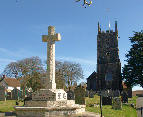Gilbert Davey was born in Winkleigh on 13 July 1893 and his father was Daniel Davey who had married Sara Jane Marks about 1888. Gilbert was eventually the third of seven children. Although there had been Davey families in Winkleigh throughout the census period and before, Gilbert’s grandfather Thomas had come from Cornwall where he had married Grace Whearn and soon moved to Devon as a farm labourer. Thomas and his family frequently moved all around Devon, possibly constantly looking for work as the industrial revolution was continuing to reduce farming jobs. Thomas finally settled in Winkleigh around 1870. The reduction in jobs continued into the 20th century, especially with the arrival of the petrol engine, and Gilbert’s job was only as a cow boy in Eggesford when he was 18 at the time of the 1911 census. This poor outlook for him possibly encouraged him to sign on in the Royal Navy because it was relatively well paid and was permanent work. Gilbert signed on in Devonport on 29th September 1913 for 12 years after being at a Training Establishment for six months. He was described as being 5ft 5in tall with a fresh complexion, brown hair and blue eyes.
When Gilbert arrived at Devonport, he was taken on immediately as a Stoker class 2 and given eight months further training there before being posted to HMS Marlborough on 4th June 1914. The Marlborough had been built at Devonport Dockyard during the previous two years and was commissioned when Gilbert went aboard. She was one of the last Dreadnought battleships to be built, having ten 13.5 inch guns, twelve 6 inch guns, two 3 inch anti-aircraft guns and four submerged torpedo tubes. She was 622ft 9in long with four steam turbines powering four propellers giving her a top speed of 21.25 knots. Her compliment was 925 sailors. The main armour belt was 12 inches (300 mm) thick at the waterline reducing in stages elsewhere. Although Gilbert’s rank was Stoker, the Royal Navy had kept the name when applied to engines powered by oil as was the Marlborough, hence the longer training at Devonport prior to his posting was to introduce Gilbert to the tasks associated with oil powered steam engines.
HMS Marlborough joined the 1st Battle Squadron of the Grand Fleet, then based at Scapa Flow. Gibert was given ten days leave in September before rejoining the Marlborough on the 29th for the rest of the war. The Marlborough was the flagship of the 1st Battle until February of 1917. During this time the Marlborough saw action at the Battle of Jutland which was the biggest sea battle that there has ever been. German shipping had been blockaded since early in the war and the German objective was to lure the Grand Fleet to Germany so to could be destroyed. When the German Navy started to leave port at the end of May, the Grand Fleet set out to stop them. After firing 162 13.5 inch shells during the battle, HMS Marlborough was hit by a torpedo that killed two and wounded two others. Gilbert may have been one of those wounded. Marlborough had to be towed back to port with a slight list. After repairs were finished on 29 July, 1916, she returned to the Grand Fleet. The battle had continued all day, but the German fleet managed to return to port that night, so the Grand Fleet returned to Scapa Flow. The outcome of the battle was indecisive and is still discussed today. The German Navy did not succeed in destroying the Grand Fleet, but the British lost more ships and men than the Germans. The positive result for the British was that the Kaiser decreed that the German Navy should not put to sea unless success was assured. Submarines continued to be a constant threat and sunk two more ships of the Grand Fleet a few weeks after the Battle of Jutland.
Four months after the Battle of Jutland, Gilbert was promoted to First Class Stoker and remained with the Marlborough until 31st March 1918 when he returned to Dartmouth for further training. Within a week he was promoted to Leading Stoker and continued at the Dartmouth shore establishment Vivid II until he was transffered to HMS Ramillies for practical training for three months. There followed a succession of periods on board a number of ships punctuated by visits to Dartmouth. In 1925 he renewed his contract with the Royal Navy when he is reported that he had a tattoo on his right arm and an operation scar in both groins (wounded at Jutland?). He was promoted to Acting Stoker Petty Officer early in 1927 and to Stoker Petty Office on 8th February 1928 while he was on HMS Cornwall where he received his Long Service medal. The next year his service record was continued in the War Office and which can be seen by his relatives.
28 October 2012


